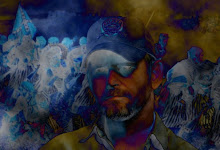 The air mobile training we did mostly involved Korean troops. I remember flying American troops a couple of times. The Americans were large, heavy, and slow loading and unloading. It was tough getting a Huey off the ground with a full load of Americans onboard. The Koreans on the other hand were small, light, and fast. The aircraft usually came off the ground quite easy.
The air mobile training we did mostly involved Korean troops. I remember flying American troops a couple of times. The Americans were large, heavy, and slow loading and unloading. It was tough getting a Huey off the ground with a full load of Americans onboard. The Koreans on the other hand were small, light, and fast. The aircraft usually came off the ground quite easy.The Koreans, especially the Tiger Brigade, also had a tough reputation from their service in Vietnam. It was said they would build large bonfires at night while no one else dared, and the Vietcong did not mess with them. If the Vietcong did mess with the Korean Tiger Brigade, they soon learned to regret it.
 Foster and I were in the chalk four position of a flight of five. I was sitting in the left seat.
Foster and I were in the chalk four position of a flight of five. I was sitting in the left seat.Our LZ was a saddle. A saddle consists of two hill tops and the dip between the two. The lead aircraft landed on the top of the hill on the left. Chalk two hovered against the slope descending left to right. Chalk three landed in the trough between the two hill tops. Chalk four, Foster and I hovered against the slope descending right to left. The trail aircraft landed on top of the hill on the right.
It was Foster's turn on the controls and I was sitting in the left seat, as Foster hovered against the slope, while I sat watching the Korean soldiers jump out of the aircraft. The right side of the aircraft was close to the ground, so those soldiers had an easy, short jump from the aircraft to the ground. The soldiers exiting the aircraft on the left side had every bit of ten feet of air to pass through before they contacted the ground.
I remember sitting in the left seat watching them jump out. Besides their weapons, they each carried forty pound packs on their backs. They would exit the aircraft and scream toward the ground. When their feet would hit, their knees would buckle and then they would rapidly head off into the bushes. I sat there watching and thinking, "Dang! I'm glad I don't have to do that."
At that time we were taking a shortcut in the interest of expediency. Each seat had individual seatbelts. Allowing the soldiers to use the individual seatbelts proved slow. In Vietnam the use of seatbelts was rare to nonexistent so I was told. Often the birds didn't even have any seats in them. The soldiers simply sat on the floor. Our rear cabin seats were setup as a bench facing the door. Five soldiers sat on each side. Our crewchief sat in a forward facing seat just behind and between the pilot and copilot's seats. The crewchief assisted with loading and unloading. Some of them were known to toss slow moving troops out the door. Our shortcut involved using a single cargo strap on each side of the aircraft to secure all five troops on each side.
When we came in for a landing the crewchief would undo one end of the cargo strap so the troops could disembark. While probably not near as safe as individual seatbelts, the cargo strap was more than they did in Vietnam, and proved faster than allowing individual troops to deal with their own individual seatbelt.
I sat there watching each troop disembark in turn when the last one jumped out. The crewchief shouted, "we're clear". Foster began to pull pitch to take off from the slope we were hovering against. I watched the last troop's feet scream for the ground. When they were only one foot above they were snatched out from under him. He crashed down on his back with eyes wide open.
I was temporarily nonplussed. The troops feet were hung up in the end of the cargo strap. The strap had stretched tight with only a foot to go. As Foster started to lift the soldier off the ground, the crewchief shouted for us to wait because one was hung up. Foster smoothly and cooly backed the aircraft up and down as the crewchief wrestled to pull the tangled strap loose.
I watched the soldier again glad it wasn't me. A trickle of blood came out from the side of his mouth. His eyes were still wide open. Finally the crewchief was successful in getting the strap loose. The Korean soldier climbed to his feet and hurried off into the bushes to join his buddies. The crewchief informed us that we were clear again, and Foster then completed a smooth takeoff.
This flight probably wouldn't have been memorable if the soldier had not gotten hung up.
Ciao!
ps Regarding speed. One of the Vietnam vets told me about a resupply mission in Vietnam where the vietcong had the helipad zero'd in with mortars. The aircraft would fly in, flare over the pad as the crewchiefs tossed stuff out the door during the flare, then quickly roll forward and pull pitch for departure. As the Huey barely cleared the pad, a couple of mortars would strike behind them.







0 comments:
Post a Comment